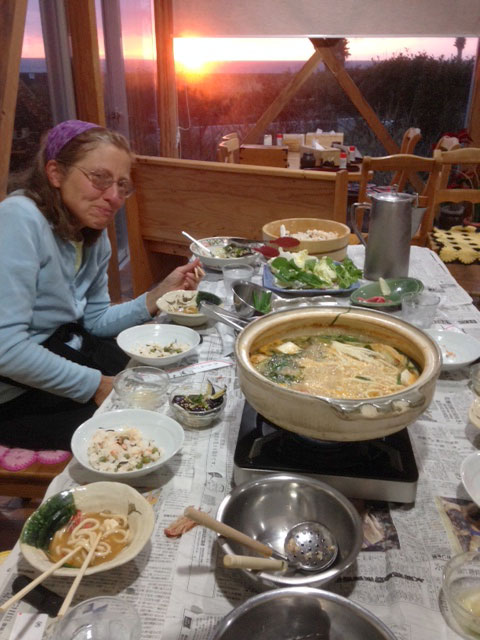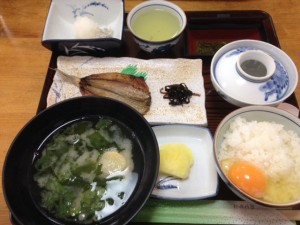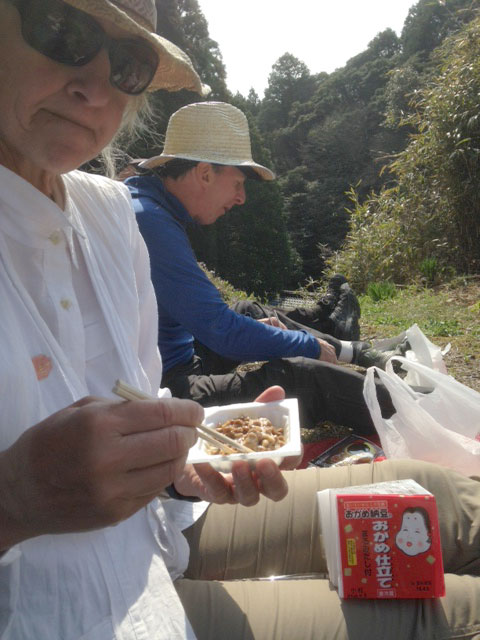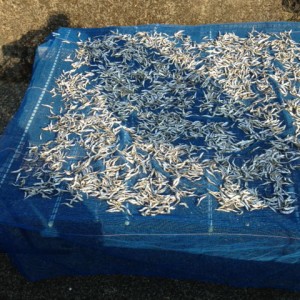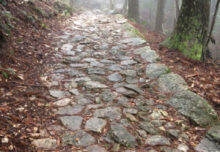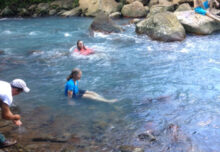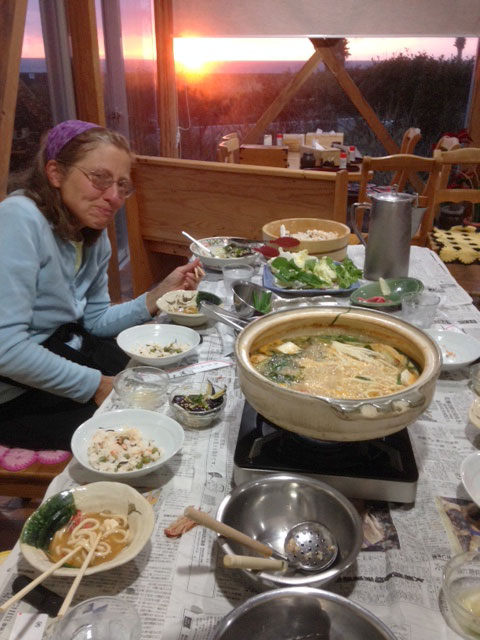
We are now in our third week of walking the Shikoku 88 Temple pilgrimage and we’ve been averaging fifteen miles a day. That means we have the pleasure of eating breakfast, morning snack, first lunch, second lunch and dinner.
Breakfast is served early at the minshuku, family inns, that cater to the walking Henro, pilgrims. Our host two nights ago didn’t give us a choice when I asked about asa-gohan, breakfast. He opened up his right hand to spread all five fingers and then tapped his palm with the index finger of his left hand, the Japanese way of showing six. “Wakata, rokuji,” I said. I understand, six o’clock.
When I am at home I often postpone my first meal of the day until mid-morning but I know I can’t skip breakfast and expect to keep my energy high for walking all day. I drink the morning miso soup, crunch through the pickles, pick the bones out of the fish and eat a bowl of white rice. The only thing I haven’t been able to do is mix the raw egg on my tray into my rice bowl. Tom says it tastes good, if you add a bit of soy sauce, but he never wants to have a second raw egg, mine.
Morning is a great time to walk and we usually get in several miles before we find a fast food store to buy our next batch of calories. Onigiri, or rice balls, are fresh and inexpensive and contain a bit of seaweed or pickled plum in the center.
They go well with natto, a fermented soybean product that is served in small containers with tiny plastic bags of yellow mustard and soy sauce. It is part of the pleasure to squeeze the little bags onto the beans, stir them in and use chopsticks to bring the sticky mass to the mouth. A couple of weeks ago Mark was eating natto at first lunch when a group of Japanese hikers walked past. They were stunned that a foreigner could eat natto, a national oddity food. We didn’t tell them that we all like natto far more than most of the dried fish products in the stores.
Once in awhile we find a bigger grocery store to do our lunch and snack shopping. We wander around the aisles looking for familiar foods but also willing to try new ones. Mark is allergic to shrimp so I make sure the salad or rice ball he’s interested in doesn’t have ebi in it. I like to check out the display of fresh pickles, ranging from bright yellow slices of daikon, a huge radish, to the black curls of a sweet seaweed pickle that often shows up at breakfast. And of course we’ve discovered sweets we like. Jeanne found a chocolate bar called Big Thunder and we all like Pocky, straw-width cookie sticks covered in chocolate.
It’s citrus season in Shikoku so our meals often include oranges or grapefruit that we find for sale in little wooden boxes along the side of the road. Once Jeanne found strawberries, fresh from a long greenhouse behind the farm stand. And Mark and I are always looking for kumquat trees so we can discreetly pick a few of the tiny orange fruits and put them in our pockets. As we walk along we pop them into our mouths, skin and all, for a delicious citrus burst.
The Japanese diet is very healthy but the Japanese also make tasty snacks that aren’t as wholesome. Tom and Mark try out every bakery we pass by and if they can’t find one they buy mini-mart pastries, soft and buttery and often with sweet bean paste in the center. As illiterates though we often make mistakes. Mark bought what he thought was a cheese Danish but the top was actually fish paste. He fed most of that pastry to the ducks in the river we walked along.
By the time we get to late afternoon we’ve usually visited at least one temple and walked our miles for the day. We look forward to finding our lodging, doing some stretching, relaxing in a hot bath and, of course, eating dinner.
The evening meal at a minshuku is served at low tables in a room with tatami mats. The Japanese guests sit comfortably on their lower legs but I long ago lost that flexibility so I sit cross-legged or in an awkward bent leg sprawl. In front of each guest the hostess places a tray of small dishes and before I eat a bite I always admire the way the food is displayed, each mouthful artfully arranged. At one particularly delicious meal I counted thirteen different serving dishes for each guest. I would not want to be the dishwasher at a minshuku.
And one last word about food in Shikoku: fish. We’ve been walking along the southern coast of this island that faces out to the wide Pacific Ocean. Every day we walk through fishing villages where trays of silvery fish dry in the sun and piles of hardwood are stacked next to metal buildings. We peer inside and see smoked fish on heavy metal trays. Last night we ate dinner at a small family restaurant as our lodging didn’t serve meals. The menu featured several pages of different kinds of fish, each one illustrated with a detailed drawing.
We have only three more days of walking before we will get on a train that will bring us back to busy urban Japan. I will miss the simple rhythm of our walking days and the surprises we find around every corner. And I will miss the home-cooked meals at each little inn, the pickles and the fish, and the smiles as we thank the cooks. Goshisosamma deshita. It was delicious.

